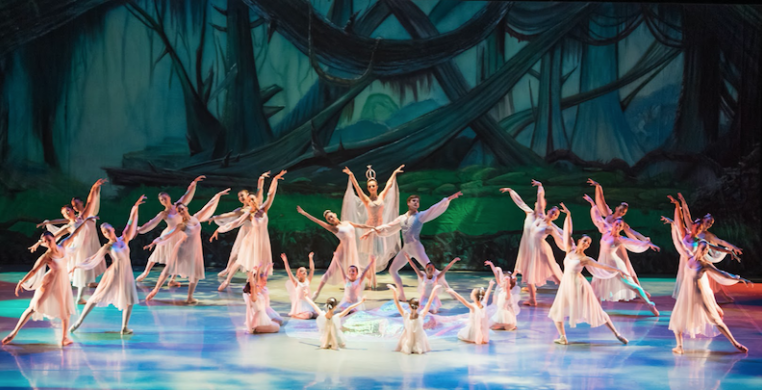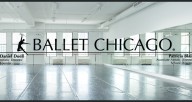If you’re into time travel, grab a free ticket and hop on board “Balanchine + Beyond,” Ballet Chicago’s 2021 virtual season, with seven weekly installments beginning Saturday and continuing through April 2.
Ballet Chicago artistic director and former New York City Ballet principal dancer Daniel Duell has faced the restrictions of the “stay-at-home” mandate and cancellation of the company’s annual live seasons at Chicago’s Harris Theater with glass-half-full resilience.
Duell is proud to report there have been no staff lay-offs, with faculty providing a full complement of virtual classes and supplemental programming for the Studio Company and students.
Ballet Chicago’s creativity in sustaining operations throughout the pandemic is testimony to the determination, leadership and support of its administration, board of directors, artistic staff, dancers and their families.
“Balanchine + Beyond,” curated by Duell, associate director Patricia Blair and choreographer-in-residence Ted Seymour, consists of seven archival film programs, each focusing on a different, specific aspect of the Balanchine legacy.
The first of these commemorates Black History Month with “Heralding the Black Aesthete.” Part one presents six pieces developed for “Dance Vision 2020: The Music of Black Voices,” in collaboration with Merit School of Music. Created at-home during quarantine, “Heralding the Black Aesthete” features composers and artists Billy Strayhorn, Herbie Hancock, Florence Price and Maya Angelou, musicians from Merit School of Music, and the Ballet Chicago Studio Company. Part two highlights Duell’s highly acclaimed “Ellington Suite,” an evocative and jazzy sequencing of dances, filmed from the stage of the Harris Theater in 2017.
Duell characterizes the second week’s offering, “Bravo Balanchine,” as “very classical, with neo-classic accents.” He introduces this program with historic and anecdotal context-setting. “Concerto Barocco” (1941) is set to the Double Violin Concerto in D Minor by J.S. Bach, and “Divertimento #15” (1956) set to music by Mozart. Considered one of Balanchine’s greatest masterworks, “Concerto Barocco,” exemplifies his revolutionary genius for making music visible through the physicalization of instrumentation, melody, rhythms, tempos and dynamics. Nowhere is this more apparent than in his use of Bach’s "Concerto in D Minor for Two Violins," where two lead ballerinas personify the two violins. A zoom session following the performance will feature Ballet Chicago alumni who have danced these pieces over the course of several decades.
Week number three, “Fabled Family Fun,” brings two beloved children’s stories to life. Part one, “Hansel & Gretel,” from Grimm’s Fairy Tales (1812), combines footage of Duell’s 2018 and 2019 productions, set to an orchestral adaptation of the Humperdinck opera score performed at the Harris Theater.
Part two presents Act Three of “Coppelia,” (1870), set to the music of Léo Delibes, about a life-like doll, her magical doll-maker and the love-struck young man who falls for her. Excerpted from the original 1998 professional Ballet Chicago production with guest artists from the New York City Ballet and the Richmond Ballet, the concert presents the Act Three wedding scene. This production harkens back to many of the founding students of the School of Ballet Chicago and its affiliated Studio Company.
Week four, “Neo-Classic Innovations,” presents three works by resident choreographer Ted Seymour. For “Intermezzi” (2014), set to Brahms’ “Intermezzi for Piano, Opus 117,” Seymour juxtaposes a lidless grand piano center stage with configurations of dancers in duets, trios and full ensemble.
“LongLivingLine” (2007) is set to a musical mix of the baroque master Antonio Vivaldi and the modern stylings of Aphex Twin. “Celestial Rites,” set to Tchaikovsky’s “Hymn of the Cherubim,” was created for Ballet Chicago's Tchaikovsky Celebration in 2013. The entire scene takes place in the cosmos, its message the passing of destiny from one generation to the another.
Week five presents two story ballets by Seymour, “Secrets de Printemps” (2016) to music by Maurice Ravel and “Creatures of Prometheus” (2018) to the Beethoven score of the same name.
Duell describes “Kick Up Your Heels/Baila, Baila!” in week six as a fun program of Seymour’s infectious “Danzon” (2015), set to the music of Arturo Marquez and George Balanchine’s “Who Cares?” (1970), with music by George Gershwin.
Topping off the final week is footage from the 2013 and 2014 Ballet Chicago productions of Balanchine’s quintessential classical ballet, “Swan Lake,” set to one of the greatest ballet scores of all time by Tchaikovsky. Ballet Chicago received special permission from The Balanchine Trust to perform this ballet, the first time that rights had been awarded to a school to perform this work. Kirk Henning of the Suzanne Farrell Ballet dances the Prince and Denmark exchange student Benita Bunger portrayed the Swan Queen, with Sandra Jennings and Darcy Kissler supervising and coaching.
In addition to the archival films, Ballet Chicago will offer master classes, Q&A sessions with the artists and repertory studies from the choreography in each of the films.
--
"Balanchine + Beyond" screens free online from Feb. 27-April 2. For more information, click Ballet Chicago’s organizational page below, or visit www.balletchicago.org/spring.


